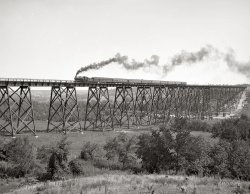
MAY CONTAIN NUTS

Search Shorpy
SHORPY ART

Framed or unframed, desk size to sofa size, printed by us in Arizona and Alabama since 2007. Explore now.
Join and Share
Ad-Free Shorpy
Shorpy is funded by you. Patreon contributors get an ad-free experience.
Learn more.

Recent comments
- Freeze Frame
- Texas Flyer wanted
- Just a Year Too Soon
- WWII -- Replacing men with women at the railroad crossing.
- Yes, Icing
- You kids drive me nuts!
- NOT An Easy Job
- I wonder
- Just add window boxes
- Icing Platform?
- Indiana Harbor Belt abides
- Freezing haze
- Corrections (for those who care)
- C&NW at Nelson
- Fallen Flags
- A dangerous job made worse
- Water Stop
- Passenger trains have right of way over freights?
- Coal
- Never ceases to amaze me.
- Still chuggin' (in model form)
- Great shot
- Westerly Breeze
- For the men, a trapeze
- Tickled
- Sense of loneliness ...
- 2 cents
- Charm City
- What an Outrage
- Brighton Park
Member Photos
The Shorpy
Print Emporium
Print Emporium
Search Shorpy
Search results -- 30 results per page
- Night Moves: 1941
- ... Bogart, George Raft, Ida Lupino and Ann Sheridan.
The railroads got smarter It's true, the boxcars equipped for hauling autos were ... Things were so bad that by the end of the 1950s, the railroads had largely lost the new car trade.
However, by the mid 1960's ... Posted by Dave - 12/04/2018 - 5:19pm -
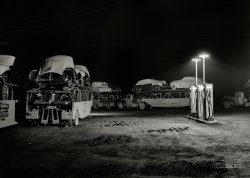
- Railroad Pageant: 1939
- ... shell to PRR K-4 #3768, the engine on the left.
Railroads on Parade
Washington Post, September 24, 1939.
Celeste ... Many Interesting Exhibits.
Don't miss “Railroads on Parade,” the colorful pageant of the iron horses of the past ... Posted by Dave - 03/17/2013 - 4:39pm -
![Railroad Pageant: 1939 May 27, 1939. "New York World's Fair, railroad pageant. Final curtain, locomotives." Large-format negative by Gottscho-Schleisner. View full size.
It does my heart goodMy reaction to this image of locomotives was "Wow!" They look absolutely beautiful. I may just have to put this print on my wish list.
What did one locomotive say to the other?Want to get together and blow off some steam?
End of that eraThe streamliner steam engine on the left represented 1939's top technology, while the old timer on the right recalled the 100-year railroad past at that time. But within 15 years, both engine types would be replaced by first-generation diesels, which still rule the rails today.
Rare ShotThis is the largest photograph I've ever seen of a Lackawanna 4-6-4. I'm guessing she was red trimmed in gold? Would love to see more shots taken that day, particularly if they feature the star of the fair, Pennsylvania Railroad's S-1 duplex type, a one-million pound passenger engine that ran at full speed before the crowd with its drivers positioned on rollers. It had a very similar streamlined shell to PRR K-4 #3768, the engine on the left.
Railroads on Parade
Washington Post, September 24, 1939.
Celeste Weyl.
Transportation Area of World's Fair Offers Visitor Many Interesting Exhibits.
Don't miss “Railroads on Parade,” the colorful pageant of the iron horses of the past and the streamlined engines of today. In 16 scenes and actual settings and costumes of the early days, actors, horses, covered wagons, stage coaches, oxen, mules and locomotives, you see the importance of transportation in the opening of this continent. Starting over 110 years ago, at the New York water-front, in the covered wagon era, the parade of actors, chorus and ballet tells the story of America's conquest of the wilderness.
Below is a fantastic 16mm Kodachrome film of “Railroads on Parade,” by Gustave Martens, posted to YouTube by his grandson. It lacks the Grand Finale but is clearly the same set. Beautiful color.
Looks Can Be DeceivingThe locomotive on the right is actually newer and more modern that the one on the left. The Raymond Loewy styled Pennsylvania 4-6-2 was built in 1920 and streamlined later. The Lackawanna 4-6-4 was built just the previous year in 1938. One visible advancement in the photo, are the cast driving wheels on the Hudson, versus the old spoked drivers on the Pennsy K-4.
A great seriesThis is just part of a great series of photos on the LoC's American Memory Gottscho-Schleisner series. As for the 1939 World's Fair, sadly, idealism and optimism turned into cruel reality with the beginning of World War II. The Polish and Czechoslovak exhibits didn't reopen for 1940, and some Europeans were unable to return home after the fair closed.
World's largest locomotiveThe Lackawanna Hudson here is 1151 and was renumbered "1939" specifically for this fair. In 1940 it was remodeled (with feathers painted on the streamlining) and renumbered "1940". Also designed by Raymond Loewy was the 6-4-4-6 configuration S-1 mentioned by Lost World as running on rollers at the fair. Its speed was a constant 60 mph, all day, and it was the prototype for what the Pennsylvania Railroad intended to replace its fleet of K4 locomotives, which were introduced in 1914. Constructed in the PRR’s Altoona shops (very probably my father, a 38-year PRR employee, worked on it) and completed shortly before the fair, it was the largest locomotive ever built at 304 tons and just over 140 feet long. [OK, second largest. Thank you, Bob100. But it was the longest.] It was too big for most of the Pennsy trackage and less than half of its weight was on its drive wheels, two factors which gave it a very short career. The majestic S-1 was retired in 1945 and scrapped in 1949. Here’s Raymond Loewy and the S-1. Incidentally streamlined outer panels on locomotives did little for performance and got in the way of routine maintenance.
Driving wheelsAlthough they look different, the driving wheels on both locomotives are cast.
Re: World's Largest LocomotiveWhile a very large machine, this one is not quite the largest. That honor would go to the 4-88-4 ALCO Big Boy which ran on the UP. Rated at 6,290 hp, it weighed 548 tons. It was followed closely by the 2-66-6 Allegheny built by the Lima Locomotive Works which generated more horsepower at 7,638 but was 4 tons lighter. The C & O Railroad and the Virginian Railway employed these monsters hauling coal. There are several of both of these locomotives on static display. The third largest, the 4-66-4 ALCO Challenger weighs in at 485 tons and rated at 6,200 hp. It ran on the UP and there is one still active on excursion service.
It makes my heart race just watching videos of these machines pounding along the track. I've been around a few steamers, mostly Shays used in logging, and one thing that has always stood out is the feeling that you are near a living being. Listen closely to the sounds associated with steam engines, especially a locomotive. It's like you can hear it breathe. No wonder that so many crewmen grew attached to their machine. Each one had its own peculiar sounds due to pop valve configurations, expansion and contraction, exhaust valves, whistle, &c. Probably the nearest any manmade machine will ever come to being lifelike.
(The Gallery, Gottscho-Schleisner, NYC, Railroads)](https://www.shorpy.com/files/images/SHORPY_5a16875u.thumbnail.jpg)
- Red Comb Feeds: 1943
- ... of railroading a threat to life and limb.
All of the railroads represented by the boxcars here are long gone.
Fallen Flags PM ... look as if being painted.
(The Gallery, Jack Delano, Railroads) ... Posted by Dave - 04/13/2024 - 9:40pm -
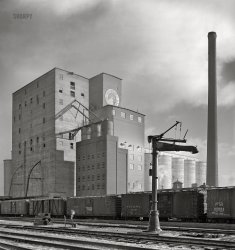
- Westbound Freight: 1943
- ... Office? Jack Delano seemed to specialize in photo's of railroads (and this one in particular) during WWII. But why?
Historic ... from natural gas drilled in Texas.
Why Photograph Railroads WWII honed logistics to a science. We had never fought a war of ... Posted by Dave - 09/05/2012 - 6:08pm -
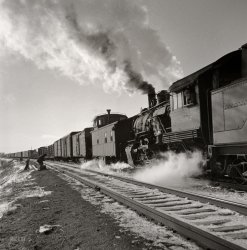
- Blue Island Yard: 1943
- ... on until after WWII.
(The Gallery, Jack Delano, Railroads) ... Posted by Dave - 04/15/2024 - 1:33am -
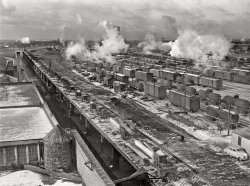
- Levee Work: 1903
- ...
R.R.s Can anyone identify the A&V and S.I.C.V. railroads?
Reporting Mark I've only been able to find the A&V which ...
Thanks for showing us a long-gone New Orleans.
The railroads are the Alabama & Vicksburg, which ran between Meridian and ... Posted by Dave - 07/19/2012 - 4:35pm -
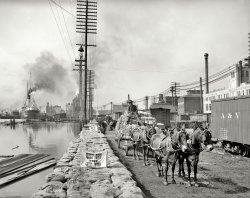
- Owego: 1901
- ... Most of the building shown are still there.
Owego Railroads The tracks very visible in this view were of the Delaware, ... in this picture.
(The Gallery, Boats & Bridges, DPC, Railroads, Small Towns) ... Posted by Dave - 11/28/2022 - 10:39pm -
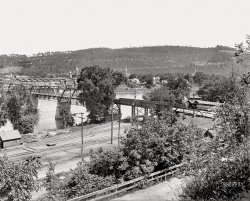
- Feed Me: 1943
- ... behind the locomotive.
(The Gallery, Jack Delano, Railroads) ... Posted by Dave - 04/12/2024 - 2:49pm -
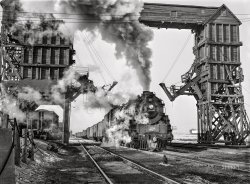
- The Woman in the Window: 1943
- ... a hard time reaching it.
(The Gallery, John Vachon, Railroads, WW2) ... Posted by Dave - 04/16/2024 - 11:25pm -
![The Woman in the Window: 1943 May 1943. "Beaumont, Texas. Wartime occupational replacement by women in men's traditional jobs. Lady in signal tower who operates block signals for railroad crossing." Medium format acetate negative by John Vachon for the Office of War Information. View full size.
Just add window boxesTwo fallen flags --
MEC Maine Central: The Pine Tree Route
T&NO Texas & New Orleans: a subsidiary of the Southern Pacific Railroad
Whether it's a tower to control trains or highway gates, it is well-built, airy, and in need of some flower boxes to complement this sturdy structure
I wonderif the lady managed to get his attention. He seems to be engrossed on his phone?
NOT An Easy JobThis is not an easy job.
In my young days before I came to the USA, I was a conductor Guard on British Railways (as it was known then). Part of the training was to observe the signalman in the signal box (as they were called back then), and to see how that job functioned.
The strength needed to pull those levers was tantamount to doing the job correctly.
Kudos to that lady for doing that job.
You kids drive me nuts!She's clearly yelling at the brakeman to stay off his dang smartphone while he's working
WWII -- Replacing men with women at the railroad crossing.Postwar world -- Replacing both with automatic machinery.
Just a Year Too SoonThe film noir "Woman in the Window" premiered in 1944 with an innocent Clark Kent-like Edward G. Robinson becoming involved with a beguiling woman and a murder.
Texas Flyer wantedIs there a a ladder hidden behind the signal box, or is that what we're seeing on the leg in the foreground? (If so, it looks rather difficult to climb). But regardless, this appears to be a position where getting to work is the hardest part.
[There's also a ladder on top of the signal box. - Dave]
Indeed, but I believe she'd have a hard time reaching it.
(The Gallery, John Vachon, Railroads, WW2)](https://www.shorpy.com/files/images/SHORPY-8d19830a.thumbnail.jpg)
- Icing on the Freight: 1943
- ... View full size.
(The Gallery, Jack Delano, Railroads) ... Posted by Dave - 04/17/2024 - 2:26pm -
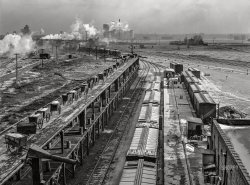
- Rolling Coal: 1942
- ... coal.
(The Gallery, John Collier, Mining, Pittsburgh, Railroads) ... Posted by Dave - 04/03/2024 - 7:00pm -
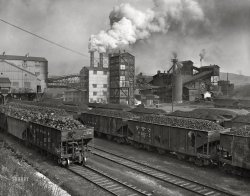
- Information Retrieval: 1942
- ... also useful to keep the numbers in perspective: American railroads handled 53 billion passenger miles in 1942 (many of them on ... polish.
(Technology, The Gallery, D.C., Gordon Parks, Railroads) ... Posted by Dave - 03/28/2024 - 10:55am -
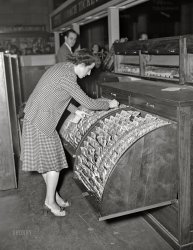
- Hybrid EV: 1942
- ... came into vogue.
(The Gallery, Chicago, Jack Delano, Railroads) ... Posted by Dave - 03/10/2024 - 2:58pm -
![Hybrid EV: 1942 December 1942. "Chicago, Illinois. One of the Chicago and North Western Railroad streamliner diesel electric locomotives. These trains are operated jointly with the Union Pacific Railroad to the West Coast." Acetate negative by Jack Delano, Office of War Information. View full size.
Not hybrid or EV.Locomotives are diesel-electric, not hybrid. The electric part is the method of power transmission between the engine and wheels because they have a 250-950rpm operating range. A gearbox would be too large and complex to be practical, especially when synchronizing multiple units. They don't charge or operate on batteries (except some at low yard speeds for shuttling).
[You're thinking about this much too narrowly. Hybrid: "Of mixed character; a thing made by combining two different elements." - Dave]
Ice BeardJust like old man winter.
Chug and playShorpy is certainly correct - but then almost all (North American) "diesels" are such: a diesel engine drives a generator that powers the traction motors. But the U.P. was strictly an amateur about combining powering methods
The SBB lok is still around - ! - but converted back to free-range capabilities.
EMD E6It looks like the EMD E-series, guessing E6, built from 1938 to 1942.
I take it backThe E-series didn't have the radiator. Lionel offered two streamliners, the M10000 and this thing. I can't find pictures of this thing that also give the model number.
Achoo-choo!It looks like its nose is running! I love that streamlined look, though. I'll bet it's sporting that striking Union Pacific armour yellow and gray paint scheme, too!
Re: Achoo-choo!You are absolutely correct!
Not an E-unit. It's an M-10000!I think that the "runny nose" comes from water in the air hoses. (Just a guess!!)
Steam HeatPassenger cars of the past used steam for heating and, in some cases, for air conditioning too. Steam locomotives had plenty, but diesel electric locomotives needed diesel oil fired auxiliary boilers. The steam is transmitted from locomotive to cars via metal pipes and couplings. In freezing weather, it seemed one could always see whisps of steam here and there - perhaps the valve beneath the pilot (steel plate above the rails) was slightly cracked open to prevent freezing. Once can see minor damage to the pilot - perhaps the locomotive encountered a vehicle somewhere at a crossing.
Only a handful of these machines were built before larger and more powerful locomotives became available. I recall reading that one of these locomotives struck a skunk which splattered over the area where we see the frozen steam. The large, automobile-like grilles, supposedly brought the odor into the cab making things stinky for the crew.
About that runny nose.Water is never permitted in a trains air hose. A frozen brake line is a train wreck looking for a place to happen.
Passenger engines such as this one have (had) a steam generator on board to supply a steam pipe to the entire train for heating, air conditioning, cooking, etc. The ice on the pilot would be condensate from this steam line.
Corrections (for those who care)This locomotive is a Pullman-Standard M-10005 or M-10006, produced in 1936 -- a descendant of the "original" M-10000 from 1934, which was already retired a year when this photo was taken. These were predecessors of the famous EMC/EMD "E" series locomotives produced by EMD starting in 1937.
Additionally, the icicle "beard" was caused by leaking steam from the steam train line -- steam was used to heat (and cool in summer for coaches that had steam-ejector air conditioning installed) the passenger coaches, and was produced by steam boilers on the locomotive. Steam was used on all conventional passenger equipment until the late 1970s when electrical head-end-power (HEP) came into vogue.
(The Gallery, Chicago, Jack Delano, Railroads)](https://www.shorpy.com/files/images/SHORPY-8d11464u.thumbnail.jpg)
- Public Square: 1900
- ... replaced the horsecars on its line in 1893.
Western Railroads TerryN, thanks for pointing out the CM&StP sign in the window. ... Rock Island. The interesting thing is that none of these railroads served Cleveland, at least not directly. They all went from Chicago ... Posted by Dave - 04/07/2023 - 11:19am -
![Public Square: 1900 Circa 1900. "City Square. Soldiers' and Sailors' Monument, Cleveland." 8x10 inch dry plate glass negative, Detroit Photographic Company. View full size.
The May Co. BuildingWow, looks like the predecessor of the modern curtain-wall design. Large lights of 1/4" plate glass no doubt. Would love to see some architectural drawings of that facade.
Chicago Milwaukee & St. Paul Soon to become The Milwaukee Road, with Hiawatha service to almost anywhere. Brook Stevens who designed their rail cars would have (maybe did) marveled at the May Co. building of the future.
I'm marveling at in this picture. Probably 50 years before its time.
No rebellious women?One would think there would have been at least one daring young woman who would have had the gumption to wear a black blouse with a light colored skirt, just to be a little outrageous and stand out, but nooooo. Times sure have changed in the area of seeking attention through outrageous fashion and personal appearance. Or maybe today's girls just feel more comfortable expressing themselves, which certainly does make street scenes more interesting.
Where's the Cable Car?http://www.cable-car-guy.com/html/ccohio.html#cccr
According to the above link, the cable car slots under the trolley car were used for another year until 1901, even thought the St. Clair trolley car in the foreground had directly replaced the horsecars on its line in 1893.
Western RailroadsTerryN, thanks for pointing out the CM&StP sign in the window. The same building also has signs for the Burlington Route and Rock Island. The interesting thing is that none of these railroads served Cleveland, at least not directly. They all went from Chicago westward. So their offices in Cleveland must have been for exchange of freight between eastern and western railroads, I suppose.
Euclid BeachA year later, the Humphrey family would take over Euclid Beach Park east of the city, and turn it into a legend.
You can still buy their popcorn at many stores in NE Ohio.
The Edison patented lightbulb goes onAfter seeing so many flagless giant flagpoles on major buildings here on Shorpy, it finally dawned on me that they were not intended for a US flag, but for advertising/corporate ID, as can be seen here.
Inside the Monument?It appears that there is a door leading into the monument itself. Does anyone know what this leads to and is the interior still accessible? Secret enterance to the Great Lakes Brewing Company tasting room perhaps?
[What's inside the Civil War monument is addressed in the comments here. - Dave]
May Co. reduxHere's a later view of the May Co. building, greatly expanded.
One has to wonder if this postcard is again the work of Detroit Publishing.
The gardensI like the surrounding gardens that have been made into the shapes of Unit or Division emblems and heroism awards.
(The Gallery, Cleveland, DPC, Streetcars)](https://www.shorpy.com/files/images/4a08340a.thumbnail.jpg)
- Mantrip: 1942
- ... helped me:
(The Gallery, John Collier, Mining, Railroads) ... Posted by Dave - 03/31/2024 - 5:20pm -
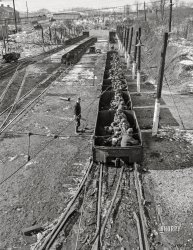
- Clinton: 1943
- ... on the left and still exists today.
Two depots, three railroads The Chicago & Northwestern passenger depot is the large ... Town
Many photos and info about the depots and railroads that served Clinton.
(The Gallery, Jack Delano, Railroads) ... Posted by Dave - 10/26/2016 - 5:17pm -
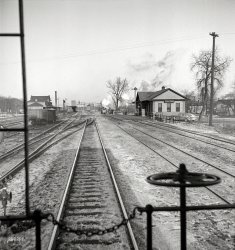
- Clean Energy: 1942
- ... to break it up.
(The Gallery, John Collier, Mining, Railroads) ... Posted by Dave - 03/30/2024 - 4:22pm -
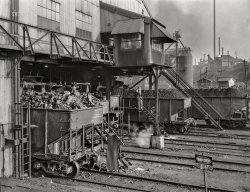
- The Hump Master: 1942
- ... week..
(Technology, The Gallery, Chicago, Jack Delano, Railroads) ... Posted by Dave - 03/20/2024 - 11:27am -
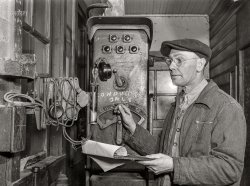
- Coal Goes to War: 1942
- ...
(The Gallery, John Collier, Mining, Pittsburgh, Railroads, WW2) ... Posted by Dave - 03/27/2024 - 11:35am -
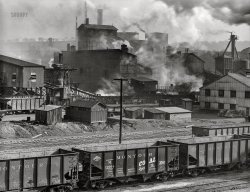
- Heart of Cleveland: 1950
- ... Terminal.
(The Gallery, Boats & Bridges, Cleveland, Railroads) ... Posted by Dave - 04/06/2024 - 5:22pm -
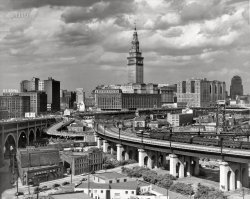
- Toledo: 1909
- ... Publishing Company. View full size.
Long gone railroads These railroads are so long-gone, that the companies that took these over are also ... Posted by Dave - 10/22/2011 - 7:24am -
![Toledo: 1909 Toledo, Ohio, circa 1909. "Maumee River waterfront." 8x10 inch dry plate glass negative, Detroit Publishing Company. View full size.
Long gone railroadsThese railroads are so long-gone, that the companies that took these over are also long-gone.
Hocking Valley Ry became part of Chesapeake and Ohio, which is in turn part of today's CSX Transportation.
Toledo and Ohio Central and Kanawha and Michigan were both absorbed by New York Central System. NYC as part of Conrail, was split up between Norfolk Southern and CSX Trans.
Hocking Valley, Kanawha and Michigan and Toledo & Ohio Centraland ... lots of Hocking Valley Railway, Kanawha and Michigan Railroad and Toledo and Ohio Central Railroad train cars to be seen.
Toledo? You ask how I know of Toledo, Ohio,
Well, I spent a week there, one day
They've got entertainment to dazzle your eyes
Go visit the bakery and watch the buns rise.
Code BreakerI wonder if all transmissions aboard the Jay C. Morse are done in code.
Spotted over above right, a roof hoarding advertising the Snow Flake Laundry, what a great name, hopefully not too indicitive of the weather patterns in Toledo.
Jay C. MorseThe ore freighter is named for the industrialist co-founder of one of the era's most powerful steel and mining companies (Pickands, Mather & Co.). In 1899, at age sixty, Jay Morse married Seville Hanna, the widow of his business partner James Pickands and sister of the sitting president's "Karl Rove," Mark Hanna. Morse died August 22, 1906, and on July 21, 1907 his widow helped to launch the steamship bearing his name.
Is it live, or is it Memorex?Please excuse the audio reference to obviously visual dilemma.
This looks like the most awesome HO train setting I've ever seen!
SS. Jay C. Morse Photographed here in her first year on the lakes, the Jay C. Morse, AmShip Cleveland hull #438, was in service for over seven decades. After a final few years as a lowly storage barge, she was scrapped in the 1980s. Her wheelhouse, removed prior to commitment to the scrapyard, was saved and made into a maritime museum in her last port, Goderich, Ontario. Comparison of the the 1908 photograph with the preserved wheelhouse/museum indicate either substantial rebuilding of the bridge or complete replacement during some mid-life refit.
Boatnerd.com has a 1980 photo of her during her final years as a grain storage barge.
The Scanner, Toronto Marine Historical Society, 1978.
The bulk carrier Jay C. Morse which was acquired early in the spring of 1965 from the Interlake Steamship Company and renamed Shelter Bay (II). After operating Shelter Bay for the 1965 season, Q & O [Quebec And Ontario Transportation Co.] decided that the ship was in need of reboilering. It was not thought that the cost of new boilers for such an elderly vessel could be justified and so Q & O searched for some good used boilers which might be obtained at a more reasonable price. The company did not have far to look and decided to purchase from Marine Salvage Ltd. the boilers which were then ensconced in Bayton.
In due course, workmen went aboard Bayton and commenced pulling apart the old girl's after cabin. Her stack removed and a hole chopped down through her upper decks, the Babcock and Wilcox water tube boilers were lifted from the vessel and were carted 'round to the West Street Wharf in Port Colborne where Shelter Bay was lying. During the summer of 1966, the boilers were installed in Shelter Bay and she has operated with them ever since. Q & O, however, might better have searched elsewhere for boilers rather than taking third-hand equipment for the conversion. In recent years, Shelter Bay has been plagued with boiler problems and a particularly nasty spate of difficulties during 1977 threatened to send the boat to the scrapyard. She was reactivated in 1978 for one further year of operation but continued struggles to keep the well-worn boilers in serviceable condition are almost certain to bring the ship to the end of her career at the close of the current navigation season.
The Scanner, Toronto Marine Historical Society, 1979.
The latter steamer [Shelter Bay (II)] went to Goderich last autumn with storage grain and was sold to the Goderich Elevator and Transit Company Ltd. for use as a storage barge. She was briefly renamed Shelter B. (perhaps unofficially) but has since been rechristened D.B. Weldon (II).
The Lightship, Port Huron Museum, 1999.
[Shelter Bay of Q & O] would become the D.B. Weldon (2) and, in 1981, her forward cabins and wheelhouse would be removed to become the Maritime Museum now in display at the harbor [Goderich, Ontario].
(The Gallery, Boats & Bridges, DPC, Railroads, Toledo)](https://www.shorpy.com/files/images/4a19192a.thumbnail.jpg)
- Hump Office: 1942
- ... conditions.
(The Gallery, Chicago, Jack Delano, Railroads, The Office) ... Posted by Dave - 03/20/2024 - 11:19am -
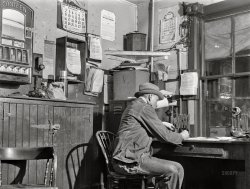
- The Hump Master: 1942
- ... The Gallery, Kodachromes, Chicago, Jack Delano, Railroads) ... Posted by Dave - 03/20/2024 - 11:24am -
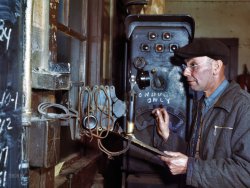
- Boilermakers: 1942
- ... say. Who knew?
(The Gallery, Chicago, Jack Delano, Railroads) ... Posted by Dave - 03/17/2024 - 3:57pm -
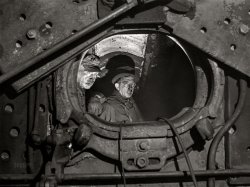
- Winter Light: 1942
- ... than Jack Delano.
(The Gallery, Chicago, Jack Delano, Railroads) ... Posted by Dave - 03/18/2024 - 3:39pm -
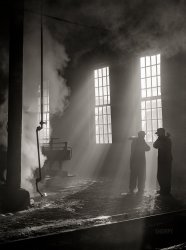
- Icy Loco: 1942
- ... the photograph.
(The Gallery, Chicago, Jack Delano, Railroads) ... Posted by Dave - 03/15/2024 - 4:48pm -
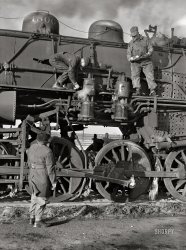
- Elko County: 1940
- ... Security Administration. View full size.
Three railroads In this shot looking northwest from the US 93 overpass, the tracks ... the 1990s.
(The Gallery, Arthur Rothstein, Landscapes, Railroads) ... Posted by Dave - 01/30/2018 - 9:58am -
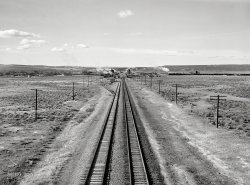
- Feeding Station: 1942
- ... train should look.
(The Gallery, Chicago, Jack Delano, Railroads) ... Posted by Dave - 03/11/2024 - 11:06am -
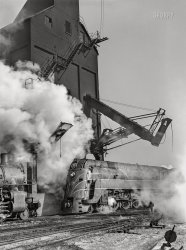
- Checkin Tender: 1942
- ... View full size.
(The Gallery, Chicago, Jack Delano, Railroads) ... Posted by Dave - 03/18/2024 - 10:36am -
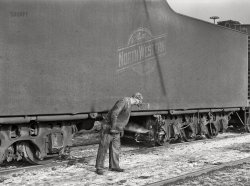
- Over the River: 1902
- ... account of Kate on the net as well.
Boone-area railroads Boone and Scenic Valley (with their Chinese-built steam loco) ... a stereoview of this somewhere...
(The Gallery, DPC, Railroads, W.H. Jackson) ... Posted by Dave - 08/03/2012 - 3:04pm -
